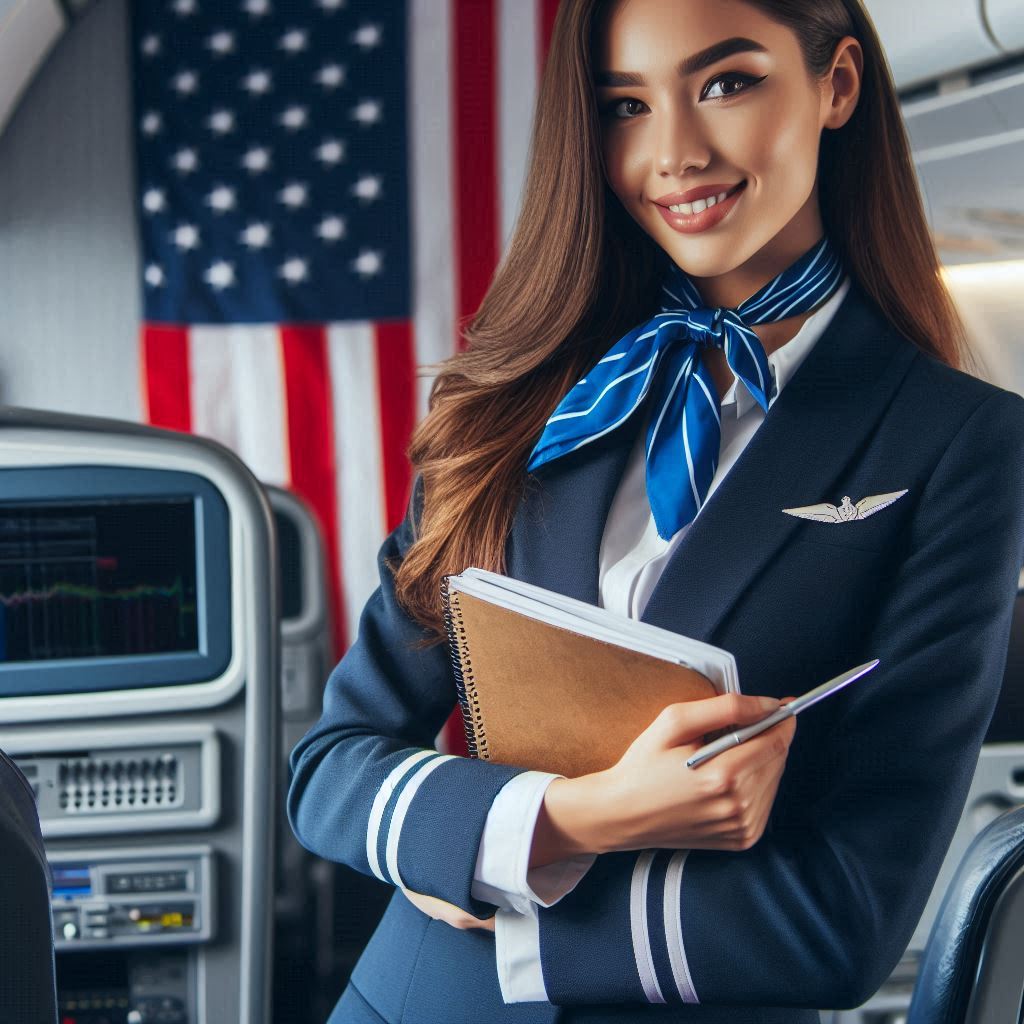Introduction
Flight Attendant Handling Emergencies play a critical role in maintaining safety during emergencies on board.
They are the frontline responders in any unexpected situation, ensuring passengers’ well-being and safety.
Emergencies can happen at any time during a flight, and passengers rely on flight attendants to manage these situations calmly and effectively.
From takeoff to landing, flight attendants are trained to handle a wide range of emergencies.
They are equipped with the knowledge and skills to act swiftly, making them essential in ensuring safe air travel.
Whether it’s a medical emergency, sudden turbulence, or a technical malfunction, flight attendants are always prepared to respond.
One of their most important responsibilities is maintaining a sense of calm and order.
Passengers look to flight attendants for reassurance, especially during stressful situations.
By staying composed, they help prevent panic and keep the situation under control.
Flight attendants undergo extensive training to handle emergency scenarios.
Their training covers everything from CPR and first aid to fire safety and evacuations.
They practice these skills regularly to ensure they are ready to act quickly and efficiently when needed.
Training and Preparation
Flight attendants play a crucial role in ensuring the safety and well-being of passengers onboard an aircraft.
Their training and preparation are key components in handling emergencies effectively.
Let’s delve into the specific training flight attendants undergo to prepare for any unforeseen situations.
The extensive training flight attendants undergo to handle various emergencies
Flight attendants undergo rigorous training programs that cover a wide range of emergency scenarios.
These programs are designed to equip them with the necessary skills and knowledge to handle any situation that may arise during a flight.
Let’s take a closer look at some of the key components of their training.
Including topics such as first aid, fire fighting, evacuation procedures, and more
First Aid
- Flight attendants are trained in basic first aid techniques to provide immediate assistance in medical emergencies.
- They learn how to assess and respond to injuries, illnesses, and other medical issues that may occur onboard.
- Having a solid understanding of first aid is essential in addressing medical emergencies promptly and effectively.
Fire Fighting
- Flight attendants receive training in fire fighting techniques to extinguish onboard fires quickly and efficiently.
- They learn how to use fire extinguishers, control smoke, and evacuate passengers in case of a fire emergency.
- Being prepared to handle fires is crucial for ensuring the safety of passengers and crew members onboard.
Evacuation Procedures
- Flight attendants are trained in evacuation procedures to efficiently and safely evacuate passengers in emergency situations.
- They learn how to direct passengers to emergency exits, deploy evacuation slides, and prioritize passenger safety during evacuations.
- Having a thorough understanding of evacuation procedures is essential in ensuring a swift and organized evacuation in critical situations.
Importance of staying calm and collected during high-stress situations
- During emergencies, flight attendants must remain calm and composed to effectively handle the situation.
- Staying calm allows them to think clearly, make quick decisions, and communicate instructions clearly to passengers.
- Remaining collected under pressure is vital in maintaining order and ensuring the safety of everyone onboard.
In essence, the training and preparation that flight attendants undergo are essential in equipping them with the skills and knowledge needed to handle emergencies efficiently.
From first aid to fire fighting and evacuation procedures, flight attendants are well-prepared to respond to various emergencies that may arise during a flight.
Their ability to stay calm and collected under pressure is crucial in ensuring the safety and well-being of passengers in high-stress situations.
Communication Skills
During emergencies, effective communication is crucial for the safety of passengers and crew members.
Flight attendants must convey instructions clearly and confidently to passengers in a calm and reassuring manner.
Clear and concise announcements are made by flight attendants to provide guidance and updates to passengers.
Importance of Effective Communication
Effective communication is the key to successfully managing emergencies on a flight.
It ensures that passengers understand the situation, know what actions to take, and remain calm throughout the ordeal.
In high-stress situations, clear and concise communication can prevent panic and confusion, ultimately saving lives.
Conveying Instructions Clearly
Flight attendants must be able to convey instructions clearly to passengers, using simple language that is easy to understand even under pressure.
They must remain calm and composed while speaking to ensure that passengers trust their guidance and follow instructions without hesitation.
Examples of Typical Announcements
- “Ladies and gentlemen, we are experiencing some turbulence. Please remain seated with your seatbelts fastened until further notice.”
- “Attention passengers, there is no cause for alarm but we are initiating an emergency landing procedure. Please listen carefully for further instructions.”
- “For your safety, please follow the crew’s directions and prepare for an emergency evacuation. Leave all belongings behind and proceed to the nearest exit.”
- “In the event of a loss of cabin pressure, oxygen masks will drop from the overhead compartments. Place the mask over your nose and mouth and breathe normally.”
- “We are experiencing technical difficulties with one of our engines. Rest assured that the pilots are trained to handle this situation. Please remain seated and stay calm.”
- “Attention passengers, we have been cleared to make an emergency landing. Please brace for impact by assuming the brace position as demonstrated in the safety card.”
These examples illustrate the importance of clear and concise communication during emergencies.
Each announcement is carefully crafted to convey essential information to passengers while maintaining a calm and reassuring tone to prevent panic and ensure the safety of all on board.
Overall, effective communication is a vital skill for flight attendants to master in order to handle emergencies with confidence and ensure the safety and well-being of passengers and crew members.
By conveying instructions clearly and calmly, flight attendants play a crucial role in managing emergencies and maintaining order during challenging situations in the air.
Read: Developing Patience and Precision in Pet Grooming
Crisis Management
Flight attendants play a crucial role in managing emergencies, ensuring the safety and well-being of passengers. Here are the steps they take in handling different types of crises:
Protocols for handling medical emergencies, unruly passengers, turbulence, and other critical situations
Medical Emergencies
- Assess the situation and provide immediate first aid if needed.
- Communicate with the flight deck for medical advice or diversion.
- Coordinate with medical professionals on board or via radio communication.
- Ensure the privacy and comfort of the affected passenger.
- Keep other passengers calm and informed about the situation.
Unruly Passengers
- Assess the level of threat and involve other crew members if necessary.
- Attempt to de-escalate the situation through calm and assertive communication.
- Follow airline protocols for restraining or removing the disruptive passenger.
- Document the incident for the airline’s follow-up and legal purposes.
- Offer support to other passengers and ensure their safety.
Turbulence and Critical Situation
- Secure the cabin and ensure that passengers are safely seated with seatbelts fastened.
- Provide reassurance and information about the turbulence or emergency to passengers
- Coordinate with the flight deck for updates and instructions.
- Prepare for emergency landing or evacuation if deemed necessary.
- Stay calm, alert, and ready to respond to any further developments.
Importance of teamwork and coordination among the flight crew
Teamwork and coordination among the flight crew are vital in crisis management:
- Assign roles and responsibilities to each crew member based on their training and experience.
- Establish clear communication channels to ensure prompt and effective response to emergencies.
- Practice regular drills and simulations to enhance teamwork and coordination skills.
- Support and assist each other in high-pressure situations to maintain a safe and calm environment.
By following these protocols and emphasizing teamwork, flight attendants can effectively handle emergencies and ensure the safety of everyone on board.
Read: Tips for Nail Technicians Working in High-End Salons

Equipment and Resources
Essential tools and resources available to flight attendants for managing emergencies
Flight attendants are equipped with essential tools and resources to effectively manage emergencies onboard.
These tools play a crucial role in ensuring the safety and well-being of passengers and crew members.
Let’s take a closer look at some of the key equipment available to flight attendants for handling emergencies.
Use of emergency medical kits, defibrillators, oxygen masks, and other safety equipment
Emergency Medical Kits
- Flight attendants are trained to use emergency medical kits in case of medical emergencies.
- These kits contain essential supplies such as bandages, medications, and basic medical equipment.
- Flight attendants can provide basic medical assistance to passengers until further help arrives.
Defibrillators
- Defibrillators are onboard devices used to deliver an electric shock to the heart during cardiac arrest.
- Flight attendants receive training on how to operate defibrillators in emergency situations.
- These devices can be life-saving in cases of sudden cardiac arrest onboard an aircraft.
Oxygen Masks
- Oxygen masks are deployed in case of a loss of cabin pressure to ensure passengers can breathe comfortably.
- Flight attendants assist passengers in donning oxygen masks and ensure their proper use.
- Proper deployment and use of oxygen masks are crucial during emergency situations.
Other Safety Equipment
- Flight attendants are trained to use various safety equipment like life vests and fire extinguishers.
- These tools are essential for ensuring the safety of passengers and crew during emergencies.
- Flight attendants play a critical role in effectively utilizing safety equipment when needed.
Role of Technology
Technology plays a vital role in enhancing communication and response time during emergencies.
In today’s modern aviation industry, flight attendants have access to cutting-edge technology that enables them to respond quickly and effectively to various emergency situations.
Let’s explore how technology contributes to improving emergency response onboard.
Communication Systems
- Flight attendants rely on advanced communication systems to stay connected with the cockpit and ground control.
- These systems enable real-time communication during emergencies, allowing for swift coordination of response efforts.
- Clear and efficient communication is essential for ensuring a coordinated and effective response to emergencies.
Emergency Alerts and Notifications
- Technology provides flight attendants with instant alerts and notifications in case of emergencies.
- These alerts help flight attendants quickly identify the nature of the emergency and take appropriate actions.
- Immediate notifications play a crucial role in expediting response time and ensuring passenger safety.
Training Simulations
- Flight attendants undergo training simulations using advanced technology to practice emergency response procedures.
- Simulations help flight attendants familiarize themselves with various emergency scenarios and hone their skills.
- Technology-enhanced training ensures that flight attendants are well-prepared to handle emergencies effectively.
In short, flight attendants are equipped with essential tools, resources, and technology to manage emergencies effectively.
The combination of specialized equipment, practical training, and cutting-edge technology enables flight attendants to respond swiftly and decisively in challenging situations, ensuring the safety and well-being of everyone onboard.
Read: Understanding Pet Grooming Safety Standards
Passenger Assistance
Flight attendants play a crucial role in providing assistance and support to passengers during emergencies.
It is a responsibility that requires a combination of skill, training, and empathy.
Transform Your Career Today
Unlock a personalized career strategy that drives real results. Get tailored advice and a roadmap designed just for you.
Start NowResponsibility of Flight Attendants
Flight attendants are trained to handle a wide range of emergency situations, from medical emergencies to onboard incidents.
Their primary responsibility is to ensure the safety and well-being of all passengers on the flight.
In the event of an emergency, flight attendants must remain calm, assess the situation quickly, and take appropriate action to address the issue.
This may involve providing first aid, coordinating with the flight crew, and implementing emergency procedures.
Protocols for Assisting Special Passengers
When assisting elderly, disabled, or unaccompanied passengers during emergencies, flight attendants must follow specific protocols to ensure their safety and well-being.
- For elderly passengers, flight attendants should provide extra assistance, such as helping them to their seats or assisting with mobility devices.
- For disabled passengers, flight attendants should be familiar with their specific needs and how to assist them in case of an emergency.
- For unaccompanied minors, flight attendants must take extra care to reassure and support them during stressful situations.
Maintaining Passenger Comfort and Reassurance
During emergencies, maintaining passenger comfort and reassurance is essential to prevent panic and confusion among passengers.
Flight attendants play a key role in keeping passengers calm and informed.
Flight attendants should communicate clearly and confidently with passengers, providing updates on the situation and reassurance that everything is being done to ensure their safety.
They should also be attentive to passengers’ emotional needs, offering support and comfort to those who may be feeling anxious or upset during an emergency.
By prioritizing passenger comfort and reassurance, flight attendants can help passengers feel more secure and confident in the face of adversity.
This can make a significant difference in how passengers handle stressful situations and emergencies onboard flights.
Read: Understanding Nail Disorders: A Technician’s Guide
Dealing with Fear and Anxiety
The emotional aspect of handling emergencies as a flight attendant
As a flight attendant, dealing with fear and anxiety is a crucial aspect of handling emergencies.
These emotions can arise in various situations, such as severe turbulence, medical emergencies, or onboard disturbances.
It is essential to address the emotional aspect of managing these feelings while maintaining professionalism.
Strategies for Managing Personal Fears and Anxieties
- Practice deep breathing techniques to calm your mind and body.
- Focus on the tasks at hand and follow emergency procedures diligently.
- Seek support from your fellow crew members during challenging situations.
- Remind yourself of your training and experience to boost your confidence.
- Acknowledge your feelings but choose to respond rationally rather than react emotionally.
Importance of Self-Care and Mental Health Support
- Flight attendants often face high-stress situations that can take a toll on their mental well-being.
- It is crucial to prioritize self-care practices such as exercise, healthy eating, and sufficient rest.
- Seeking professional mental health support when needed is not a sign of weakness but a proactive step towards maintaining overall well-being.
- Flight attendants should be encouraged to talk openly about their feelings and seek help when necessary.
- Companies should provide access to mental health resources and support programs for their employees.
Overall, managing fear and anxiety as a flight attendant requires a combination of personal strategies, professional support, and a commitment to self-care.
By prioritizing mental health and well-being, flight attendants can effectively navigate challenging situations and continue to provide excellent service to passengers.
Post-Emergency Procedures
- After an emergency situation is resolved, flight attendants follow a series of important steps.
- Debriefing is crucial to assess what worked well and what could be improved for future emergencies.
- Reporting the incident accurately is essential for regulatory purposes and to prevent similar incidents.
- Documenting incidents helps in creating a repository of data that can be used for training or analysis.
- Flight attendants play a vital role in reassuring passengers and restoring calm after a distressing event.
Once an emergency has been successfully handled, there are specific procedures that flight attendants must follow to ensure the safety and well-being of passengers.
These post-emergency steps are crucial in maintaining order and preparing for any further developments.
Debriefing
One key aspect of post-emergency procedures is debriefing.
light attendants gather to discuss the events that transpired, evaluating the effectiveness of their response and identifying areas for improvement.
Debriefing allows the crew to learn from the experience and make adjustments to their emergency protocols.
Reporting and Documentation
Accurate reporting of the incident is essential.
Flight attendants must document all relevant details of the emergency, including the actions taken and any issues that arose.
This information is used for regulatory purposes, compliance, and to create a record that can be referenced in the future.
Documentation is critical in identifying patterns, weaknesses, and strengths in emergency procedures.
Role in Reassuring Passengers
After the chaos of an emergency, passengers may feel anxious or scared.
Flight attendants play a crucial role in reassuring passengers, providing them with information, and maintaining a sense of calm.
By showing professionalism, empathy, and competence, flight attendants help to restore normalcy and instill confidence in the passengers.
Overall, the post-emergency procedures are just as important as the initial response.
Debriefing, reporting, and documenting incidents not only help in improving future responses but also ensure that the safety and well-being of passengers are prioritized.
The role of flight attendants in reassuring passengers and restoring normalcy after an emergency cannot be understated.
Conclusion
Flight attendants play a vital role in handling emergencies, ensuring passenger safety and comfort at all times.
They are trained extensively to respond quickly and efficiently during critical situations.
Their ability to remain calm under pressure is essential for managing any emergency.
One of their primary responsibilities is to ensure the cabin is prepared for emergencies.
They make sure passengers understand safety procedures and know what to do in case of an emergency.
From securing overhead bins to instructing passengers on proper evacuation methods, flight attendants are constantly focused on safety.
In the event of a medical emergency, flight attendants are often the first responders.
They are trained in first aid, CPR, and using defibrillators.
This quick action can save lives, especially when medical professionals aren’t immediately available.
Their ability to communicate clearly with both passengers and ground personnel is crucial in these moments.
Another key responsibility is crowd control during high-stress situations.
Whether it’s turbulence, a fire, or a security threat, flight attendants must keep order in the cabin.
Their authoritative and calming presence helps prevent panic, which could worsen the situation.
Communication is another crucial skill for flight attendants.
They must effectively relay instructions to passengers and communicate with the cockpit crew.
Their ability to convey clear, concise messages is vital, especially when every second counts.
Ensuring passengers understand and follow instructions can be the difference between chaos and calm.
Crisis management training prepares flight attendants for the unexpected.
They are taught how to handle various emergencies, from mechanical failures to natural disasters.
This training includes evacuation procedures, using emergency equipment, and assisting passengers with special needs.
Their preparedness ensures that they can act swiftly, minimizing potential harm.
Compassion also plays a significant role in their duties.
[E-Books for Sale]
The Big Book of 500 High-Paying Jobs in America: Unlock Your Earning Potential
$19.99 • 500 High-Paying Jobs • 330 pages
Explore 500 high-paying jobs in America and learn how to boost your career, earn more, and achieve success!
See All 500 High-Paying Jobs of this E-Book
1001 Professions Without a Degree: High-Paying American Jobs You Can Start Now
$19.99 • 1001 Professions Without a Degree • 174 pages
Discover 1001 high-paying jobs without a degree! Unlock career tips, skills, and success strategies for just $19.99!




